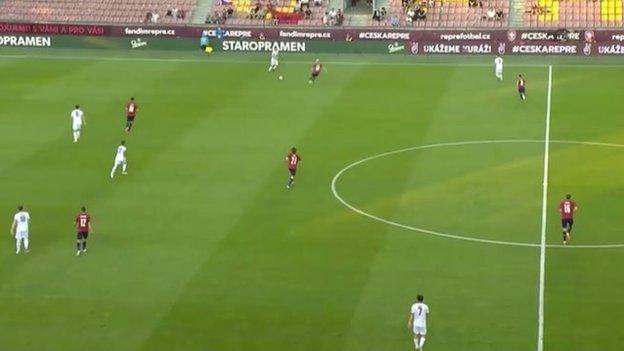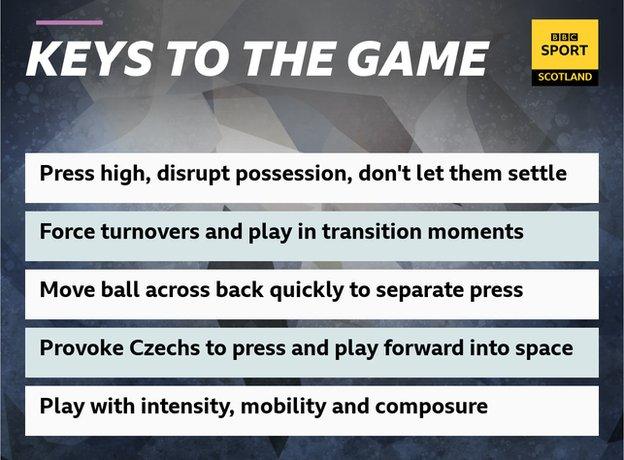Euro 2020: How do Scotland beat the Czech Republic?
- Published

Win the opening game of Euro 2020 against the Czech Republic and Scotland could feasibly qualify for the knockout stages for the first time.
It's not quite that easy, obviously, but with four of the six third-placed finishers in the groups qualifying for the last 16, three points might be enough to advance.
Given England and Croatia are also in the group, the meeting with the Czechs at Hampden is our most winnable game. It's also one the team will be confident about after home and away victories against Monday's opponents last autumn.
But how does Steve Clarke's side beat the Czechs?
What are their strengths?
The Czechs are a good team with several quality players, notably West Ham United stand-out Tomas Soucek, a powerful box-to-box midfielder who scored 13 goals last season.
Jakub Jankto of Sampdoria is a technical, creative player who can hurt Scotland if given time to thread passes into the final third and get himself into good positions around the box.
Striker Patrik Schick is dangerous too. The Bayer Leverkusen forward has been involved in around 100 goal contributions by the age 25, scoring nine goals in the Bundesliga last season.
The Czechs typically line up in a 4-2-3-1 formation, with Slavia Prague's Jan Boril and Vladimir Coufal of West Ham offering width and mobility from the full-back positions, Soucek and Vladimir Darida the main players in midfield, and Jankto off the left.
With Schick as the frontman, they can play into space and open the game up, giving them an outball on the counter-attack.
Who is their player to watch?

Young Sparta Prague forward Adam Hlozek looks to have all the ingredients to reach the very top level. At 18 years old, he has an eye for goal, clever movement and is sharp to lose his marker.
One for the fantasy football players among us?
How can Scotland trouble them in possession?
Defensively, the Czechs will look to begin in a 4-2-3-1 block, starting to press as the ball travels across the back before stepping up and defending man-to-man in midfield. Often, that means they give up the space behind the midfield line.
Against Albania, they had issues cutting off the supply against a wide back three with the two midfielders in deeper positions allowing easy passes into the strikers.
Scotland can expose and exploit the press, particularly behind the full backs when they step out high to defend against a wing-back, often isolating the central defender.
The Czech Republic pressing shape leaves gaps behind the midfield line into the striker. Scotland playing in a back three allows them to spread the play as wide as possible and create gaps to play into. Kieran Tierney, for example, can dribble into such spaces and take out three players.
Then, if Scotland make a first-time pass to turn and play from, they can take out six players with two passes diagonally from Tierney into midfield, then the far side.

Kieran Tierney, in possession, has the chance to take three Czech players out the game
And what about without the ball?
The Czechs look to build from the back but have a rigid system that can be pressed quite easily. Scotland in a 3-5-2 can press man-for-man on the central players and set traps on the full backs using a mixture of the striker, wing-back and outside central midfielder.
We have already seen in Scotland's 1-0 win at Hampden last year what happens when we apply an aggressive press on the full-backs. We can recover the ball in an advanced area and break with pace and numbers.
The Czechs start with a high and wide base, meaning the full-backs will always struggle to recover if the ball is lost in midfield. Scotland cannot allow them easy possession in midfield.

Ryan Fraser stays onside and Lyndon Dykes makes the pass with the outside of his foot that leads to a great chance and a goal
By playing an aggressive, front foot back-five, they can defend passes into feet comfortably and force turnovers, which emphasises their strengths and exposes the Czechs' weaknesses.
To win, Scotland will need to make it an aggressive, transitional game, with lots of turnovers and early balls in behind.
The Czechs have a lot of technical players but lack pace and mobility - that is something Scotland can expose. By pressing high, forcing it down the Czechs' left, setting traps and either winning the ball in a wide area or intercepting passes into the strikers, they can launch attacks after a regain and break with regularity.
The Czechs will want an organised, open game, with lots of longer phases of possession. Scotland are perfectly set up to get in their faces early, disrupt that and expose them in the phases of disorganised play.
